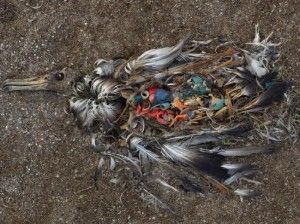Huge plastic waste dumps float in the Oceans bigger than continents. Some 10% of world’s plastic waste finds its way into the sea and ends up in the central regions where slow moving circular currents trap debris into one large constantly moving mass of plastic. This is slowly being broken down into a plastic dust that marine wildlife mistake for food. Small fish consume tiny bits of plastic as if they were normal plankton. Those fish are then consumed by larger species and the plastic contamination moves up the food chain. Over a million seabirds, as well as more than 100 thousand marine mammals, die every year from ingesting plastic debris. Some researchers estimate that there are over six kilos of plastic for every kilo of naturally occurring plankton in the Pacific plastic waste dump.
Dead seabirds having mistaken plastics for food, have been found with discarded plastic lighters, water bottle caps and scraps of plastic bags in their stomachs. / Oceanic gyres: the circular movement of the ocean waters concentrates the plastic in the centre of the oceans.
But maybe things are not as bad as it looks: scientists working on the pollution saw that it did not grow in 22 years, even if the plastic production grew fourfold. An organism may be eating plastic in the ocean, but whether the bug is green or mean remains to be seen.
